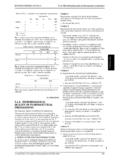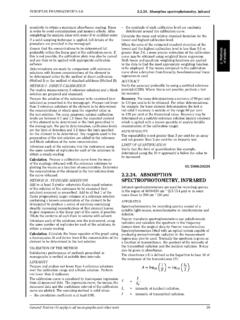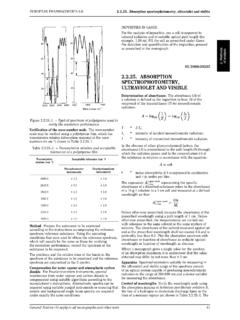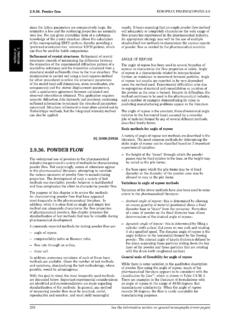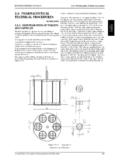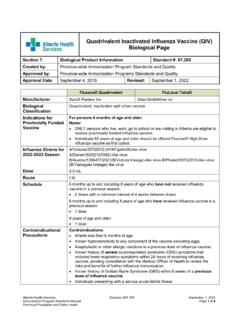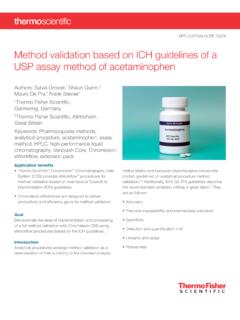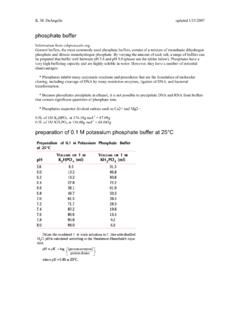Transcription of 2.6.14. Bacterial endotoxins EUROPEAN PHARMACOPOEIA 6
1 Bacterial endotoxinsEUROPEAN PHARMACOPOEIA mgCrystal violet1mgPurified water1000 mlAdjust the pH so that after sterilisation it is at25 C. Boil for 1 min with constant shaking then sterilise inan autoclave using a validated VassiliadisSalmonellaenrichment brothSoya gMagnesium chloride gSodium gDipotassium gPotassium dihydrogen gMalachite gPurified water1000 mlDissolve, warming gently. Sterilise in an autoclave using avalidated cycle, at a temperature not exceeding 115 C. ThepH is to be at 25 C after heating and , lysine, deoxycholate gLactose gSodium gYeast gPhenol red80 gSodium gSodium gFerric ammonium gPurified water1000 mlAdjust the pH so that after heating it is at 25 to boiling, cool to 50 C and pour into Petri agarPancreatic digest of gMagnesium gDipotassium gPurified water1000 mlHeat to boiling for 1 min with shaking.
2 Adjust the pH sothat after sterilisation it is at 25 C. Sterilise in anautoclave using a validated salt agarPancreatic digest of gPeptic digest of animal gBeef gSodium gPhenol gPurified water1000 mlHeat to boiling for 1 min with shaking. Adjust the pH sothat after sterilisation it is at 25 C. Sterilise in anautoclave using a validated medium for clostridiaBeef gYeast gSoluble gGlucose gCysteine gSodium gSodium gPurified water1000 mlHydrate the agar, dissolve by heating to boiling withcontinuous stirring. If necessary, adjust the pH so that aftersterilisation it is at 25 C. Sterilise in an autoclaveusing a validated agarPancreatic digest of gMeat peptic gHeart pancreatic gYeast gMaize gSodium gAgar, according to gelling gPurified water1000 mlHydrate the agar, dissolve by heating to boiling withcontinuous stirring.
3 If necessary, adjust the pH so that aftersterilisation it is at 25 C. Sterilise in an autoclaveusing a validated cycle. Allow to cool to 45-50 C; add, wherenecessary, gentamicin sulphate corresponding to 20 mg ofgentamicin base and pour into Petri Bacterial ENDOTOXINSThe test for Bacterial endotoxins is used to detect orquantify endotoxins of gram-negative Bacterial originusing amoebocyte lysate from horseshoe crab (LimuluspolyphemusorTachypleus tridentatus). There are3 techniques for this test: the gel-clot technique, whichis based on gel formation; the turbidimetric technique,based on the development of turbidity after cleavage of anendogenous substrate; and the chromogenic technique,based on the development of colour after cleavage of asynthetic peptide-chromogen :Method method: limit testMethod method: semi-quantitative testMethod kinetic method182 See the information section on general monographs (cover pages) EUROPEAN PHARMACOPOEIA Bacterial endotoxinsMethod D.
4 Chromogenic kinetic methodMethod E. Chromogenic end-point methodMethod end-point methodProceed by any of the 6 methods for the test. In the eventof doubt or dispute, the final decision is made based uponmethod A unless otherwise indicated in the test is carried out in a manner that avoids all glassware and other heat-stable apparatusin a hot-air oven using a validated process. A commonly usedminimum time and temperature is 30 minutes at 250 C. Ifemploying plastic apparatus, such as microtitre plates andpipette tips for automatic pipetters, use apparatus shownto be free of detectable endotoxin and of interfering effectsfor the : In this chapter, the term tube includes all types ofreceptacles, for example microtitre plate of the standard endotoxin stock solutionThe standard endotoxin stock solution is prepared froman endotoxin reference standard that has been calibratedagainst the International Standard, for exampleendotoxinstandard is expressed in International Units (IU).
5 Theequivalence in IU of the International Standard is stated bythe World Health : One International Unit (IU) of endotoxin is equal toone Endotoxin Unit ( ).Follow the specifications in the package leaflet and on thelabel for preparation and storage of the standard endotoxinstock of the standard endotoxin solutionsAfter vigorously mixing the standard endotoxin stocksolution, prepare appropriate serial dilutions of this solutionusing water for Bacterial endotoxins test (water for BET).Use the solutions as soon as possible to avoid loss of activityby of the test solutionsPrepare the test solutions by dissolving or diluting activesubstances or medicinal products using water for substances or preparations may be more appropriatelydissolved or diluted in other aqueous solutions. If necessary,adjust the pH of the test solution (or dilution thereof) so thatthepHofthemixtureofthelysateandtests olutionfallswithin the pH range specified by the lysate usually applies to a product with a pH in the range of The pH may be adjusted by the use of acid, base or asuitable buffer, as recommended by the lysate and bases may be prepared from concentrates orsolids with water for BET in containers free of detectableendotoxin.
6 Buffers must be validated to be free of detectableendotoxin and interfering of the Maximum Valid DilutionThe Maximum Valid Dilution (MVD) is the maximumallowable dilution of a sample at which the endotoxin limitcan be determined. Determine the MVD using the followingformulae:Endotoxin limit: the endotoxin limit for active substancesadministered parenterally, defined on the basis of dose, isequal to:K=threshold pyrogenic dose of endotoxin perkilogram of body mass in a single hour period,M=maximum recommended dose of product perkilogram of body mass in a single hour endotoxin limit for active substancesadministered parenterally is specified in units suchas IU/ml, IU/mg, IU/Unit of biological activity, etc., of test solution: in mg/ml if the endotoxin limit is specified by mass(IU/mg), in Units/ml if the endotoxin limit is specified by unit ofbiological activity (IU/Unit), in ml/ml if the endotoxin limit is specified by volume(IU/ml).
7 =the labelled lysate sensitivity in the gel-clottechnique (IU/ml) or the lowest point usedin the standard curve of the turbidimetric orchromogenic TECHNIQUE (METHODS A AND B)The gel-clot technique allows detection or quantificationof endotoxins and is based on clotting of the lysate in thepresence of endotoxins . The concentration of endotoxinsrequired to cause the lysate to clot under standard validity of the test, confirm the labelled lysate sensitivityand perform the test for interfering factors as describedunder1. Preparatory PREPARATORY TESTING(i) Confirmation of the labelled lysate sensitivityConfirm in 4 replicates the labelled sensitivity , expressedin IU/ml, of the lysate solution prior to use in the of the lysate sensitivity is carried out when anew batch of lysate is used or when there is any change inthe experimental conditions which may affect the outcomeof the standard solutions of at least 4 concentrationsequivalent to 2 , , and by diluting the standardendotoxin stock solution with water for a volume of the lysate solution with an equal volumeof 1 of the standard solutions (such as ml aliquots) ineach tube.
8 When single test vials or ampoules containinglyophilised lysate are employed, add solutions directly tothe vial or ampoule. Incubate the reaction mixture for aconstant period according to the recommendations of thelysatemanufacturer(usuallyat37 1 Cfor60 2min),avoiding vibration. Test the integrity of the gel: for tubes,take each tube in turn directly from the incubator and invertit through approximately 180 in one smooth motion. If afirm gel has formed that remains in place upon inversion,record the result as positive. A result is negative if an intactgel is not test is not valid unless the lowest concentration of thestandard solutions shows a negative result in all (1) Bacterial endotoxinsEUROPEAN PHARMACOPOEIA end-point is the last positive result in the series ofdecreasing concentrations of endotoxin.
9 Calculate the meanvalue of the logarithms of the end-point concentrations andthen the antilogarithm of the mean value using the followingexpression:Geometric mean end-point concentration ==sum of the log end-point concentrations of thedilution series used,f=number of geometric mean end-point concentration is the measuredsensitivity of the lysate solution (IU/ml). If this is not lessthan and not more than 2 , the labelled sensitivity isconfirmed and is used in the tests performed with this lysate.(ii) Test for interfering factorsPrepare solutions A, B, C and D as shown in Table ,and use the test solutions at a dilution less than the MVD,not containing any detectable endotoxins , operating asdescribed under 1. Preparatory testing, (i) Confirmation geometric mean end-point concentrations of solutions Band C are determined using the expression described in testing, (i) Confirmation of the labelled test for interfering factors is repeated when any changesare made to the experimental conditions that are likely test is not valid unless all replicates of solutions A andD show no reaction and the result of solution C less than and not greater than 2 , the test solutiondoes not contain interfering factors under the experimentalconditions used.
10 Otherwise, the solution interferes with the preparation being examined interferes with the test ata dilution less than the MVD, repeat the test for interferingfactors using a greater dilution, not exceeding the MVD. Theuse of a more sensitive lysate permits a greater dilution ofthe preparation being examined and this may contribute tothe elimination of ,suchas filtration, neutralisation, dialysis or heat treatment. Toestablish that the treatment chosen effectively eliminatesinterference without loss of endotoxins , repeat the test forinterfering factors using the preparation being examined towhich the standard endotoxin has been added and which hasthen been submitted to the chosen (METHODA)(i) ProcedurePrepare solutions A, B, C and D as shown in Table ,and perform the test on these solutions following theprocedure described under 1.
